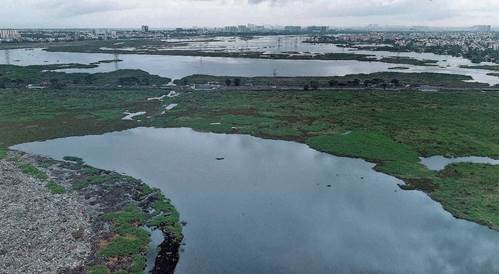Description

Disclaimer: Copyright infringement not intended.
Context: India has added five more Ramsar sites, or wetlands of international importance, bringing the number of such sites in the country to 54, Environment Minister Bhupendra Yadav said.
More on the news:
- These are the Karikili Bird Sanctuary, Pallikaranai Marsh Reserve Forest and Pichavaram Mangrove in Tamil Nadu, the Sakhya Sagar in Madhya Pradesh and the Pala Wetlands in Mizoram.
- India’s Ramsar wetlands are spread over 11,000 sq.km — around 10% of the total wetland area in the country — across 18 States.
- No other South Asian country has as many sites, though this has much to do with India’s geographical breadth and tropical diversity.
- The U.K. (175) and Mexico (142) — smaller countries than India — have the most Ramsar sites, whereas Bolivia spans the largest area with 1,48,000 sq.km under the Convention protection.
- Being designated a Ramsar site does not necessarily invite extra international funds, but the States — and the Centre — must ensure that these tracts of land are conserved and spared from encroachment.
- Acquiring this label also helps with a locale’s tourism potential and its international visibility.
- Until 1981, India had 41 Ramsar sites, though the past decade has seen the sharpest rise —13 — in designating new sites.
- Wetlands, according to the Environment Ministry, are an “area of marsh, fen, peatland or water; whether natural or artificial, permanent or temporary, with water that is static or flowing, fresh, brackish or salt, including areas of marine water the depth of which at low tide does not exceed six metres, but does not include river channels, paddy fields, human-made water bodies/ tanks specifically constructed for drinking water purposes and structures specifically constructed for aquaculture, salt production, recreation and irrigation purposes.”
- To be Ramsar site, however, it must meet at least one of nine criteria as defined by the Ramsar Convention of 1961, such as supporting vulnerable, endangered, or critically endangered species or threatened ecological communities or, if it regularly supports 20,000 or more waterbirds or, is an important source of food for fishes, spawning ground, nursery and/or migration path on which fish stocks are dependent upon.
- The National Wetland Inventory and Assessment compiled by the ISRO estimates India’s wetlands to span around 1,52,600 square kilometres.

About:
- Any wetland site which has been listed under the Ramsar Convention that aims to conserve it and promote sustainable use of its natural resources is called a Ramsar Site.
- Ramsar Convention is known as the Convention of Wetlands. It was established in 1971 by UNESCO and came into force in 1975.
- India is a party to the Ramsar Convention. India signed under it on 1st February 1982.
- There are 49 Ramsar Sites in India
- Sundarbans is the largest Ramsar Site of India
- Chilika Lake (Orissa) and Keoladeo National Park (Rajasthan) were recognized as the first Ramsar Sites of India
- Uttar Pradesh has the most number of Ramsar Sites in India.
- Renuka Wetland in Himachal Pradesh is the smallest wetland of India.
|
Ramsar Sites in India
|
Location
|
|
Khijadia Wildlife Sanctuary
|
Gujarat
|
|
Bakhira Wildlife Sanctuary
|
Uttar Pradesh
|
|
Haiderpur Wetland
|
Uttar Pradesh
|
|
Sultanpur National Park
|
Haryana
|
|
Bhindawas Wildlife Sanctuary
|
Haryana
|
|
Thol Lake Wildlife Sanctuary
|
Gujarat
|
|
Wadhvana Wetland
|
Gujarat
|
|
Ashtamudi Wetland
|
Kerala
|
|
Beas Conservation Reserve
|
Punjab
|
|
Bhitarkanika Mangroves
|
Odisha
|
|
Bhoj Wetlands
|
Madhya Pradesh
|
|
Chandra Taal
|
Himachal Pradesh
|
|
Chilika Lake
|
Odisha
|
|
Deepor Beel
|
Assam
|
|
East Kolkata Wetlands
|
West Bengal
|
|
Harike Wetlands
|
Punjab
|
|
Hokera Wetland
|
Jammu & Kashmir
|
|
Kanjli Wetland
|
Punjab
|
|
Keoladeo National Park
|
Rajasthan
|
|
Keshopur-Miani Community Reserve
|
Punjab
|
|
Kolleru lake
|
Andhra Pradesh
|
|
Loktak lake
|
Manipur
|
|
Nalsarovar Bird sanctuary
|
Gujarat
|
|
Nandur Madhameshwar
|
Maharashtra
|
|
Nangal Wildlife Sanctuary
|
Punjab
|
|
Nawabganj Bird Sanctuary
|
Uttar Pradesh
|
|
Parvati Agra Bird Sanctuary
|
Uttar Pradesh
|
|
Point Calimere Wildlife and Bird Sanctuary
|
Tamil Nadu
|
|
Pong Dam lake
|
Himachal Pradesh
|
|
Renuka lake
|
Himachal Pradesh
|
|
Ropar Wetland
|
Punjab
|
|
Rudrasagar Lake
|
Tripura
|
|
Saman Bird Sanctuary
|
Uttar Pradesh
|
|
Samaspur Bird Sanctuary
|
Uttar Pradesh
|
|
Sambhar lake
|
Rajasthan
|
|
Sandi Bird Sanctuary
|
Uttar Pradesh
|
|
Sarsai Nawar Jheel
|
Uttar Pradesh
|
|
Sasthamkotta lake
|
Kerala
|
|
Surinsar- Mansar lakes
|
Jammu & Kashmir
|
|
Tsomoriri
|
Ladakh
|
|
Upper Ganga river
|
Uttar Pradesh
|
|
Vembanad Kol Wetland
|
Kerala
|
|
Wular lake
|
Jammu & Kashmir
|
|
Sunderban Wetland
|
West Bengal
|
|
Asan Barrage
|
Uttarakhand
|
|
Kanwar Lake or Kabal Taal
|
Bihar
|
|
Lonar Lake
|
Maharashtra
|
|
Sur Sarovar
|
Uttar Pradesh
|
|
Tso Kar Wetland Complex
|
Ladakh
|
https://epaper.thehindu.com/Home/ArticleView
1.png)















